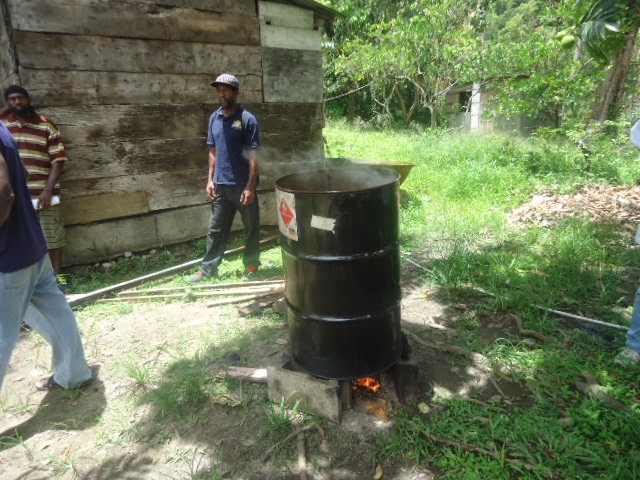You have been attempting organic production. Land preparation and establishment of crops has been a success with Compost. In the process of scouting, you observe one caterpillar. Then two. And overnight you have two hundred on one plant! Abandoning your attempt at organic farming seems to be the follow-up activity in the sequence of organic farming practices. But wait, there is hope yet! At a training workshop held on Thursday July 24, 2014, the use of plants for biological control of pests was demonstrated.
 |
| L-R: Adelfa (red), Adelfa (pink), Neem |
The plants selected for today's demonstration were:
- OLEANDER: A fixture of the home garden, this plant has great POTENTial for organic pest control. You can identify the plant by the dull green, slender pointed leaves with clusters of flowers at the end of the branches. The flowers range in colour from white through cream, pink rose and red. Participants were cautioned of the toxicity of the plant. In handling the plant, one should not eat, drink nor smoke. So poisonous is this plant, that even food cooked on the wood is poisoned. Does this leave any doubt in your mind that the Oleander can be effective in pest control? It can be used to control ants, flies, caterpillars and other insects. Other names by which this shrub is known includes Adelfa, Rose Bay and Rosa Fancesca.
- NEEM: The use of neem as a biological pesticide is known far and wide due to its commercialisation. The seeds are a more concentrated source of the pesticidal ingredient than the leaves. The seeds (kernels) are used to make neem oil. Neem is used in the control of pests such as beetles, termites, scale insects, mealy bugs and aphids.
It's bubbling and it's not soup
METHOD:
- Crush and boil leaves, seeds or bark for 30 minutes
- Let cool
- Pour into spray can
- Add soap mixture (Grate one bar of blue soap and add to 5 gallons of water; Use 500mL to 1 spray can)
- Spray!
POINTS TO NOTE:
- The Oleander can also be crushed and SOAKED for 30 minutes (See Step 1). It is more poisonous when boiled than soaked.
- Neem is most effective under humid conditions or when the insect and the plants are damp.
- Cover the container when boiling (regardless of plant selection) to prevent the entry of light as light reduces the potency. The cooled extraction should also not be be exposed to sunlight.
- The boiled contents are only good for 48 hours.
- After mixing with soap, the solution is only effective for 8 hours.
This can be tailored to both large scale production and production for home use. For home use, I would recommend Adelfa as the better option as it is widely available and can be soaked instead of going through the boiling method.

I want to know what to do when considering pest control on our house? I heard that pest control Coffs Harbour is one of the best pest management solutions for insects, termites and more.
ReplyDeleteHello Nortan, Thanks for reading and your comment. However, this blog is about outside in the home garden. I am not able to assist with pest control inside the home. Wish you well in getting the information you need.
ReplyDelete